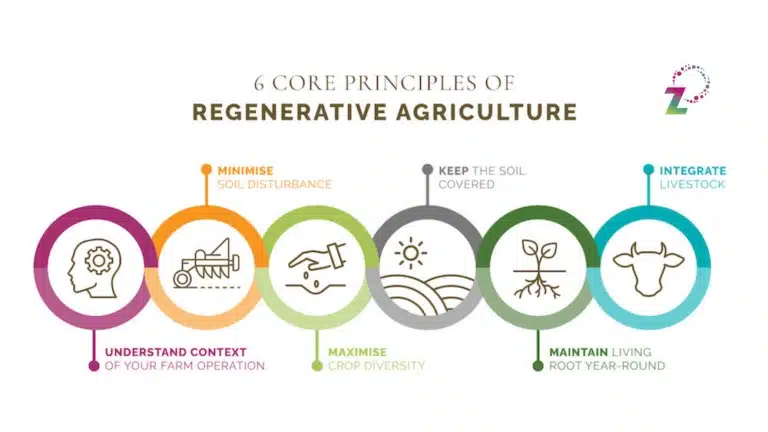
Regenerative Soil Practices: The Only Feasible Future for Food Crops
The modern agricultural approach has primarily been chemically orientated, incorporating practices that degrade the soil. The use of herbicides and pesticides in an output-focused system may have resulted in increased yields and production, but this has often taken place at the expense of the wider environment and soil health.
A major threat to the world’s food supply is climate change. Millions of farmers around the world are facing hotter summers, violent storms, years of drought and erratic harvests. This can partially be blamed on agricultural practices, which are estimated to have released 135 billion tons of carbon into the atmosphere since the start of the Industrial Age, emissions that remain there to this day. Another study led by Oxford University published in the journal Science noted that: “even if fossil fuel emissions were eliminated immediately, emissions from the global food system alone would make it impossible to limit warming to 1.5°C and difficult even to realise the 2°C target.” This means that we’ll need to make major changes to how food is produced to meet the goals of the Paris Agreement.
Part of the solution to these problems can be found in an ancient form of agriculture, now referred to as regenerative agriculture. At the foundation of regenerative agricultural practices is using regenerative soil practices to promote biologically active and healthy soil.
Regenerative agriculture 101
The phrase “regenerative agriculture” was only coined in the 1980s, but the practice itself dates back thousands of years to indigenous and small-scale farming methods around the world.
Regenerative farms follow a few basic principles:
- Disturb the earth as little as possible
- Never leave the soil bare
- Embrace biodiversity above and below ground
Large- and small-scale farmers who give regenerative agriculture a try say they’re able to boost yields and increase profits while healing the planet at the same time.

Want to learn more about regenerative agriculture in South Africa? READ OUR COMPREHENSIVE GUIDE |
The benefits of a healthy soil cannot be understated
- Healthy soils retain more water and form reservoirs that feed beneficial microbes while storing moisture—this means less irrigation is needed and more nutrients are available for plants
- With more microbial activity and organic matter, plants can access the nutrients stored in the soil, and are less reliant on chemical inputs to survive
Examples of regenerative soil practices
Getting off the chemical treadmill
One of the key principles of regenerative agriculture is enabling plants to form a symbiotic relationship with soil microbes. Here’s how:
- Plants release exudates from their roots
- Soil microbes feed on these exudates
- In return, soil microbes supply plants with essential nutrients
However, this relationship is destroyed when artificial fertilisers are applied to the soil:
- Plants stop producing root exudates
- Instead, they absorb the artificial fertiliser
- The natural relationship between plant roots and the soil microbes is destroyed
- This forces the plant to become reliant on fertilisers to grow
As plants become reliant on inputs, farmers are forced to put in more work and chemicals. Regenerative agriculture aims to break this dependency by limiting the application of chemical fertilisers and pesticides.
Crop rotation
Different crops have different nutritional needs and varying vulnerabilities to diseases and pests. For this reason, rotating the type of crop grown in a specific location can reduce the depletion of nutrients in the soil, thus regenerating the soil to a more optimal state. This also reduces the need for pesticides and fertilisers.
The regenerative soil practice of crop rotation means alternating crops with different characteristics. For example, one season a farmer might plant crops that have a lot of nitrogen; another season they might plant crops that use a lot of nitrogen. Other rotations could focus around sod-based and row crops; crops that attract certain insects; or crops that suppress weeds.
Avoiding bare soils at all times
Bare soils are exposed to the elements and lose integrity and organic life. One of the ways of keeping soils covered is to grow cover crops in between harvests. Cover crops support soil life, help retain nutrients and increase organic matter in the soil. Another option is to apply compost (green manure) to the soil. This suppresses weeds and feeds soil microbes in the absence of living roots in the ground.
Composting
Composting is a process that transforms biomass into food for the soil, improving plant growth, health and vigour. Any plant material can be composted. Decaying plant material is consumed by worms, bugs and beneficial microbes, which exude biomass as a byproduct. When worked into the soil, composted material (such as biochar) adds nutrients and reduces compaction, which allows water to penetrate deeper into the ground.
No till
Minimising or eliminating tillage helps to create a healthier soil life and ensures that carbon sequestered in the soil is not released into the atmosphere. Tilling destroys the complex fungal and microbial networks that make up the earth’s microbiome. It also releases valuable moisture into the air while unleashing billions of tons of carbon into the atmosphere.
Intercropping or polycultures
Monocropping has become commonplace in large-scale agricultural operations around the world. This is the practice of growing the same crop on the same land, year upon year. This depletes soil nutrient levels, makes the soil less productive over time, reduces organic matter in the soil, and can cause significant erosion.
Intercropping or polycultures, on the other hand, combine crops that grow in harmony with each other, building natural resilience and regenerating the soil through diversification.
Transition to regenerative soil practices with RegenZ
Moving away from traditional growing practices to regenerative soil practices can take time as soil biology restores. The move also needs to be feasible and sustainable. That’s why many farmers choose to use the services of a regenerative agriculture consultant to help them incorporate regenerative soil practices as part of a wider sustainability strategy.
Contact the regenerative farming experts at RegenZ to learn more.

About the Author: Alex Platt
Alex is Business Development Manager at RegenZ. He's inspired by the potential of regenerative farming and takes a special interest in the technology and products that are moving agriculture in a more sustainable direction.
3 comments on “Regenerative Soil Practices in Agriculture”
Lumka Mangala
2 years agoThis is a very informative article. I am a soil scientist myself and I believe in most of the points put forward.
alex1
2 years agoThanks Lumka. We have a writer that puts in a lot of effort to creating these articles so we are glad you find them informative.
Hennie Saaiman
2 years agoWell done,so relevant that one talk about the problem every day-create a natural vision about the subject.
Would it be possible to rate the top three institutions that have a reputable trustworthy source to forecast climate change ?
Too many “coffee club”story writers about this scary reality, with absolutely no peer review.
Comments are closed.